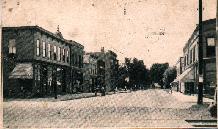Continued....
In the summer of 1846, a small congregation began holding fortnightly services in the log schoolhouse on the Ridge. Mr. Huntoon became the groups class leader. On July 13, 1854, Mr. Huntoon was present in the schoolhouse on the first quarterly conference of the Methodist Church in Evanston.
The first church building, a simple wooden structure, was dedicated in July of 1856. "Father" Huntoon was appointed a Superintendent of Sunday Schools of the new church and his son George M. was appointed steward elect and class leader. This church, now the First Methodist Church of Evanston, celebrated its 125th anniversary in 1979.
After 1873, residents of the newly-organized village of South Evanston decided they should have their own Methodist Church. (By 1850, the Grosse Pointe district had been divided into several self-governing townships, one of which was Ridgevill. In 1855, the northern sector or Ridgeville township was then known as Evanston.) Again, George W. Huntoon was a leader in this enterprise.
At the first quarterly conference in July 1873, George W. Huntoon was elected a trustee and steward of the South Evanston Methodist Church.
At the groundbreaking ceremony for the South Evanston Church, it was reported that among the participants were "Father" Huntoon, his son Willian B. Huntoon, and Reuben F. Huntoon, the eldest son of George M. Huntoon. Reuben, it was reported later in the "Evanston Index," also participated in the construction of the church building.

(Taken from "A Pictorial History of Northwestern University 1851-1951")
Much of George W. Huntoon's original homestead had been sold over the years, but he still owned a valuable strip of land on the north side of Lincoln Avenue. The following article, published in the Evanston Index in August 1873, described the promising future for South Evanston, especially of the west side, where the Huntoons resided:
It was during this time of economic uncertainty, in early 1874, that George M. Huntoon decided to build a new residence for his elderly parents. The new house would provide Mr. and Mrs. Huntoon with a comfortable place in which to spend their later years.
Several weeks later, the house stood completed. The following report appeared in the Evanston Index a week before Christmas, 1874:
In the years to follow, the Evanston Huntoons would begin to disperse, with many members of the family relocating to points west. Thus there were continuing their family's westward migration, begun many years before by George Washington Huntoon.

Picture taken about 1990, photo donated by Ruth Huntoon
After the death of his wife, Mr. Huntoon spent several weeks with his daughter Melissa Whitney in Wisconsin. He returned to South Evanston in January 1876.
"Grandpa Huntoon" lived alone in his cottage for the next two years, but spent as much time as possible with his children, grandchildren and other relatives. In January 1876, the Evanston Index reported the following remarkable event, which occured following a visit with his daughter Emeline'sfamily.
Mr. George W. Huntoon, Sr., on Friday night the 21st, walked from Mr. McDaniel's residence at Wilmette, to his own home in South Evanston--a distance of 3 1/2 miles in 63 minutes. Half the distance walked on the railroad tracks. Mr Huntoon is in his 85th year, but his eyes have neither waxed dim, nor his ears heavy, and it seems as if many a day must yet come and go ere as old age serene and bright, and lovely as a Lapland night shall lead him to the grave."
In January of 1878, the Evanston Index noted the increase in bankruptcies, resulting from weakness of the local real estate business climate. In March 1878, the Huntoon and Gamble Grocers of Evanston were closed by the creditors. George W. Huntoon, Jr. (son of William B.) had been a partner in this enterprise.
At some time in 1878, George W. Huntoon, Sr. moved from his home in South Evanston and settled with his daughter Emeline McDaniel's family in Wilmette. He was 86 years old.
Shorlty afterwards, Mr. Huntoon's cottage was rented to Mr. C.W. Caitlin, a clerk for the Chicago and Northwestern Railroad.
We are not certain of the exact circumstances, but late in 1879, George W. Hunton, Sr. fell victim to the economic depression which had lingered since 1873. A lien was placed on most of his property holdings.
Title for the property was transfered on October 13, 1879 to Mr. Charles F. Grey, president of the Hide and Leather Bank.

Although Mr. Huntoon had lost the right to the lands he had settled back in 1839, he had one small consolation--that part of his original homestead would forever bear his name. To this day, that portion of his homestead is legally described as "George W. Huntoon's subdivision."
George W. Huntoon continued to live for several years with the family of his daughter Emeline McDaniel, in Wilmette. On December 9, 1881, the Evanston Index reported that "Grandpa Huntoon" celebrated his 90th birthday by a large gathering of his children grandchildren and great grandchildren at the residence of his daughter, Mrs. A. McDaniel.
Later in 1882-3, the Connortion South Evanston Directory indicated that Mr, Huntoon resided during those years with his son, William B. Huntoon, at his home in South Evanston.
On August 6, 1884, while visiting his daughter Ann (Mrs. Mancer Thompson) at Grand Ledge, Michigan, George W. Huntoon died at the age of 92. He is buried in Rose Hill Cemetery.

HOME HISTORY LINKS PHOTOS